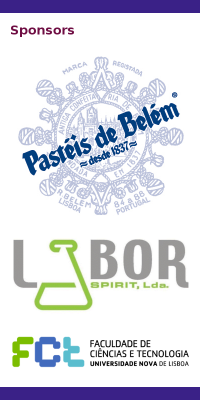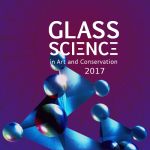Planning your stay
How to find us
The conference is being held at FCT-NOVA:
FCT-NOVA is located in the South of Lisbon, in a region now called Lisbon South Bay.
To get to the Conference location, you will probably need to travel to Lisbon, the Portuguese Capital City, and then travel a bit further to Almada, and FCT-NOVA in Campus da Caparica.
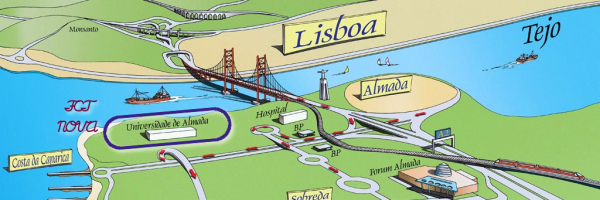
1. Getting to Lisbon
By plane:
Leaving Lisbon Airport is easy. It is just 20 minutes from the city centre, and you have an efficient public transportation network that ensures a quick and comfortable arrival at your destination.
See more information below and visit the website: Lisbon Airport.
By train:
Traveling by train in Portugal will lead you to some of the most exciting destinations imaginable. You will probably be arriving in one of these two train stations:
- Lisbon Oriente Train Station
- Lisbon Santa Apolónia Train Station
Leaving these train stations is easy. Metro (underground) and Bus services are connected to these two stations and can take you to anywhere in Lisbon or to the South Bay.
See more information below.
1.1. Transport from Lisbon airport to the city and back
Lisbon Airport is not far from the city center. From the airport you can get to the city center by underground (metro), taxi, or bus. If you don't have a lot of luggage (in which case, a shuttle service or taxi would be the best option), the best way to reach the center of Lisbon from the airport is taking the underground or the AeroBus.
1.1.1 Underground
The underground station at the airport on the red line quickly takes you to the center of the city. You will need to buy a "Viva Viagem" card (0,50 euros), and load it with as many trips as you like (or top up with euros). You can buy tickets in the automatic machines in the underground stations, choosing one of the languages available.

1.1.2 Bus
Several buses also stop right outside the arrivals terminal, and if you don't have large luggage, you can take bus 744 that runs past the major avenues uptown and ends up in the old city center.
1.1.3 Aerobus
Those with lots of luggage should perhaps take the AeroBus which runs between the airport and the city center. A ticket may be purchased directly from the driver and currently stands at 3.50 euros. They run every 20 or 30 minutes and stop at important points in the city such as Entrecampos, Campo Pequeno, Avenida da República, Saldanha, Picoas, Fontes Pereira Melo, Marquês de Pombal, Avenida da Libertade, Restauradores, Rossio, Praça do Comercio and Cais do Sodré. On board, there are screens showing each stop as the bus approaches the area.
1.1.4 Taxi
Taxis are lined up outside the terminals, and even with luggage, it should cost you between 10 and 15 euros if you are staying in Lisbon. The journey to Almada, in Lisbon South Bay, should be around 30 euros.
1.2. Transport from Lisbon Train Stations
Lisbon Airport is not far from the city center. From the airport you can get to the city center by underground (metro), taxi, or bus. If you don't have a lot of luggage (in which case, a shuttle service or taxi would be the best option), the best way to reach the center of Lisbon from the airport is taking the underground or the AeroBus.
1.2.1 Lisbon Oriente Train Station
One of the most stunning modern sights in Lisbon is the Lisbon Oriente Train Station (Lisboa Estacion Oriente). It was built by master architect Santiago Calatrava with a roof of glass and steel made to look like a row of trees. The Oriente Station is one of the world's largest stations, with 75 million passengers per year which makes it as busy as Grand Central Terminal in New York. (font: www.raileurope.com/)
To travel to other train stations, you have local services to Lisbon's Santa Apolonia Train Station on the Azambuja rail line.
Metro red line serves this station, and it is located as follows in the map.
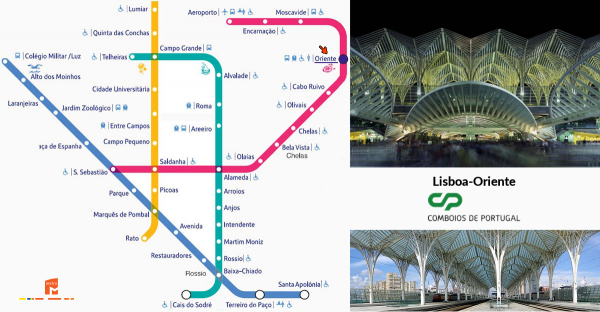
1.2.2 Lisbon Santa Apolonia Train Station
Lisbon's Santa Apolonia station (Lisboa Santa Apolonia) opened in 1865 and is the oldest railway terminal in Lisbon. Situated on the bank of the Tagus River in the historical district of Alfama of Lisbon, this station is the starting point for most international trains, and where they end their journeys in the Portuguese capital. (font: www.raileurope.com/)
To travel to other train stations, you have local services to Lisbon's Oriente Station on the Azambuja rail line.
Metro blue line serves this station, and it is located as follows in the map.
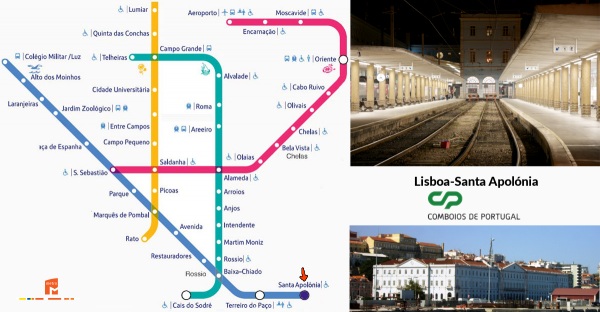
Bus lines 9, 46, and 59 will take you to downtown Lisbon.
2. Getting to Almada and Monte da Caparica
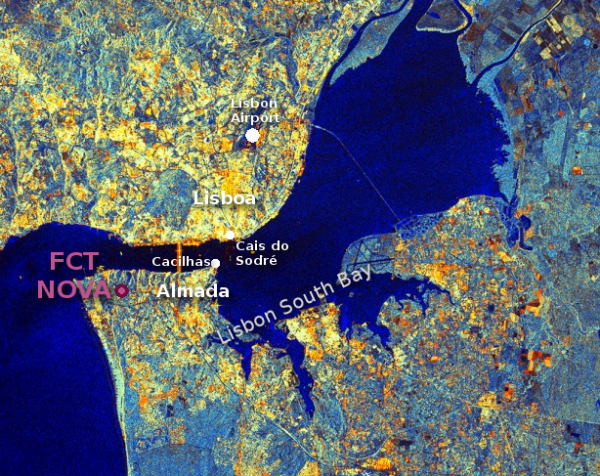
2.1. Transport to FCT-NOVA
The Faculty of Sciences and Technology (FCT NOVA), Campus of Caparica is one of the most prestigious Portuguese engineering and science public schools and it is engaged in extensive research activity developed in 16 research centres involving 1600 PhD and Master’s students of the total enrolment of 7800.
The campus is served by a wide transport network, including combined services (bus, train, ferry) and by tram, which terminus ("University") is located along one of the FCT entrances.
2.1.1. From Lisbon (Airport)
Using public transportation:
There is a special shuttle bus (Carris nr 91), that takes passengers to Lisbon downtown in 20 minutes. This bus also stops at “Cais do Sodré” Train Station, next to the Ferry Station, where you can take a ferryboat to “Cacilhas”.
Once in “Cacilhas” you can take a tram to “Universidade”, hopping off on its terminus (located near one of the campus entrances).
In Cacilhas you can also take one of the following TST buses: “Marisol”, “Fonte da Telha” or “Costa de Caparica – via Almada”. They all stop next to the FCT main entrance.
(In the airport there are other town bus lines: 5, 22, 44, 45 and 83 to Lisbon).
Another easy way to get south is to take the Metro from Airport station (Aeroporto) towards São Sebastião, change for the blue line towards Amadora Este, and exit in Jardim Zoológico (which gives you access to the Sete Rios Train Station).
Take the Fertagus Train to "Pragal" and take the tram (MTS) towards Universidade, hopping off on its terminus (located near one of the campus entrances).
By Taxi
There are always plenty of taxis at the Arrivals and Departures Halls. All the taxis have meters, a ride to FCT NOVA costs approximately €30, depending on the traffic. During weekends, nights, and holidays there is a 20% surcharge.
2.1.2. From Lisbon Santa Apolónia Train Station
Using public transportation
Metro to “Amadora Este” (blue line), get out in “Jardim Zoológico” station. Take the Fertagus train to “Coina” or “Setúbal” and get out in “Pragal”. Once there, take the tram to “Universidade”, hopping off on its terminus (located near one of the campus entrances).
By Taxi
There are always plenty of taxis outside the station. All the taxis have meters, a ride to FCT NOVA costs approximately €25, depending on the traffic. During weekends, nights, and holidays there is a 20% surcharge.
2.1.3. From Lisbon Oriente Train Station
Using public transportation
Take the Metro red line from Oriente towards São Sebastião, change for the blue line towards Amadora Este, and exit in Jardim Zoológico (which gives you access to the Sete Rios Train Station).
Take the Fertagus Train to "Pragal" and take the tram (MTS) towards Universidade, hopping off on its terminus (located near one of the campus entrances).
2.1.4. From Almada & Caparica
Using public transportation
If you are staying in Almada, which is the closest place to reach the Conference Venue, you can take a tram to get to FCT-NOVA. From Cacilhas, or any other stop along the tram line (see all stops at http://www.mts.pt/rede.php) you can take a tram to “Universidade”, hopping off on its terminus (located near one of the campus entrances).
In Cacilhas, or around Almada region, you can also take one of the following TST buses: “126 Marisol”, “127 Fonte da Telha” or “124 Costa de Caparica – via Almada”. They all stop next to the FCT main entrance.
If you are staying in Costa da Caparica, take a TST bus to “Cacilhas – via Almada” and get out in the bus stop right in front of FCT main entrance.
3. Getting to the Pharmacy Museum in Lisbon
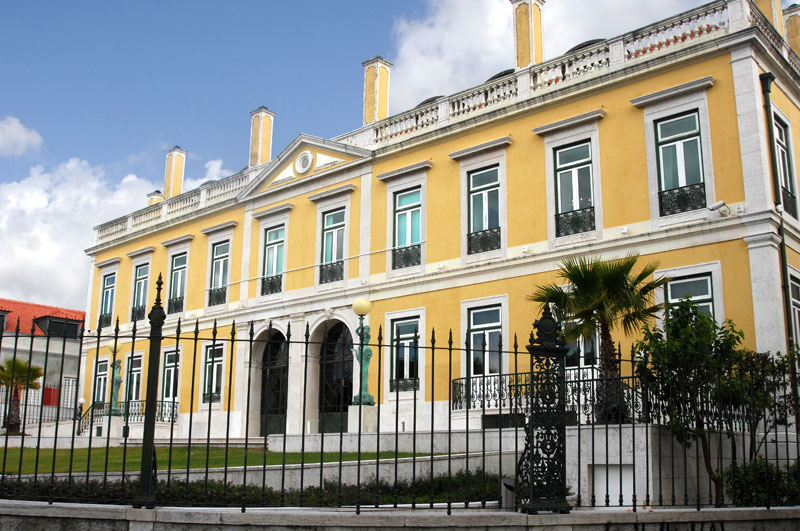
In the 8th of June, the GlassAC conference will be held in Lisbon, in the Pharmacy Museum.
3.1. If you are travelling from Almada:
Travel to Lisbon by boat (in Cacilhas -- check prices, schedules at Transtejo Website), by Train (in Pragal -- check prices, schedules at Fertagus website), or by Bus (several bus stops in Almada, and namely in front of the University campus (check prices, schedules at TST website).
All the transports arrive in Lisbon near a subway station. See 3.2 for further instructions.
3.2. If you are travelling from Lisbon:
Take the subway to BAIXA/CHIADO station.
Follow to Praça Luís de Camões, follow onto Rua do Loreto, Continue onto Largo Calhariz and then Turn left onto Rua Marechal Saldanha. The entrance to the Museum is in Rua Marechal Saldanha.
Planning your stay (accommodation)
1. Almada & Cacilhas (Recommended)
Almada has a few nice places to stay, and is the closest option to reach FCT-NOVA Venue.
The following are some suggestions, that you can check by clicking the link:
- Cacilhas Guest Apartments
- Mercure Lisboa Almada
- Hotel Residencial Colibri
- Pousada HL
- Aldeia dos Capuchos Golf & SPA
2. Lisbon
Lisbon has a great variety of places to stay, from the regular hotel, to the bed and breakfast. We also have some of the best hostels of the world , so if you are looking for a cheap stay, and a different experience, you may want to consider this option.
There are various hotels at a short distance from the conference venue, but if you prefer to stay in Lisbon, for instance in the historic center (Baixa or Chiado) it is not too far from the public service to the conference. As long as you choose a place near a subway station that will get you to Fertagus trains services towards Pragal, or from Cais do Sodré boat station (that takes you to Cacilhas, in Almada), you can enjoy both the capital city and it will not take you long to reach the conference venue.
To choose a place to stay we recommend one of the many booking websites, where you can find detailed information about the hotel, as well as comments and ratings from other users, which should help you choose according to your own taste.
|
Some of the main booking websites: |
for hostels: |
We recommend booking your stay a few months before the conference.
VISA Requirements
Please contact the Portuguese Embassy or Consulate in your Country to see if you need a visa to travel to Portugal. Please notice that the visa application and process might take some time. Unfortunately, we cannot help you in obtaining a visa.
Visiting Lisbon
Lisbon is a luminous city. The almost constant presence of sunshine and the River Tagus transforms the Portuguese capital into a mirror of a thousand colours – highlighting the city's unique architecture and beauty. There are so many things to see and do in Lisbon that visitors have access to a wide array of different experiences.
As we walk through Lisbon - whose history spans back thousands of years – we find streets filled with heritage monuments, and characteristic neighbourhoods where the city first developed and can still be experienced at its most genuine level.
There are several websites where you may find information regarding your Lisbon experience:
 |
 |
 |
 |
 |
 |
Walking around is actually one of Lisbon's biggest pleasures and it is the best way to experience the old quarters, all the way to the castle. Several viewpoints offer refreshments, stunning views, and a break to sit down if needed. The hilly labyrinthine streets and their cobblestones can be physically demanding, but these viewpoints are your reward. In between walks, an old tram is never too far away.
For longer distances, the easiest way to travel is by underground. For more information see Metro de Lisboa's website.
Visiting Almada and Costa da Caparica (beach)
Almada has always been a meeting between the Atlantic Ocean and river, a place of passage of various people for thousands of years calls today to meet with the Tagus River and the beautiful beaches bathed by the Atlantic Ocean.
Almada presents a diversity of natural parks and historic sites to visit.
Almada (more precisely in Costa da Caparica) has more than 50 beaches. Small or big, you will love to take a bath on the Atlantic Ocean besides de night life with several Bars and Pubs, among lots of restaurants.
On the southern side of the Tejo River, the Costa da Caparica is basically a long stretch of sandy, clean beaches to suit all types of beachgoer. The town of Caparica itself is a friendly yet simple affair with all the usual tourist trappings and facilities. Traditionally a fishing village, and women still peddle the fresh catch at the side of the street, it now serves mainly as the nearest summer resort for Lisboans escaping the city in the summer months and has a good variety of fish restaurants and bars.
 |
 |
What to wear
Clothing/Shoes/Weather Gear :
Pack a confortable pair of shoes because Lisbon is steep and full of cobblestone streets. Unless you’re very unlucky with the weather, you should get some bright sunshine. Sunglasses and sunscreen for the most sensitive skins are advisable.
You will be visiting in the beginning of the warmer months, so pack light clothing that is breathable and comfortable. It can be quite hot but things can also get a little chilly in the evenings, so pack light clothing you can layer if needed i.e. pashmina, scarf, cardigan, long-sleeve cotton top, etc.
Photo and Other Equipment : Don't forget your camera. Lisbon is famous for its light and from the belvederes you'll have exquisite views over the city. Remember to bring an adaptor if you come from countries with a voltage different from continental Europe. Buying an adaptor might not be very easy.


